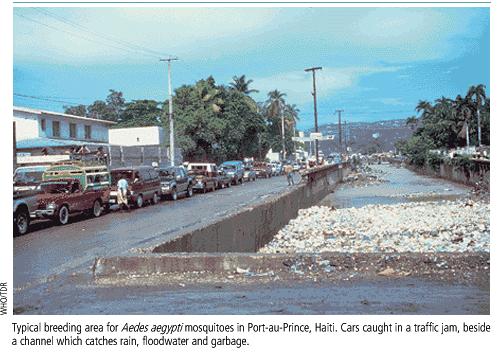Once nearly eliminated, dengue now plagues all of Latin America

Throughout Latin America, governments and international agencies are looking for new methods to deal with the ever-increasing incidence of dengue (see accompanying story on the latest outbreak in Brazil).
The number of cases reported in the Americas increased from 66 000 in 1980 to more than 609 000 last year, according to the Pan American Health Organization (PAHO) in Washington. In addition to the serious epidemic in Brazil this year, there have been outbreaks in Cuba, Mexico and Central America. María Rocío Sáenz, Costa Rica's Health Minister, warned on 12 May that a new epidemic was possible in parts of the country where there have been outbreaks before, as the rainy season gets under way.
The dengue virus, which at one point was close to being eliminated in the Western Hemisphere, has spread in recent years because of air travel and the rapid growth of cities with poor water supply, sewage disposal and sanitation. Historically, governments have tried to control outbreaks of dengue by fumigating to eliminate the mosquitoes, and trying to get rid of stagnant water. But these government-directed programmes have limited effectiveness, according to Jorge R. Arias, PAHO's regional adviser for communicable diseases, because of the lack of affordable pesticides and difficulties in changing people's behaviour. "It's like quitting smoking," he said.
A project first conducted in the Dominican Republic and now under way in El Salvador seeks to involve the people who are most at risk for dengue fever in finding solutions they can live with.
According to Julia Rosenbaum, a medical anthropologist with Project Change of the Academy for Educational Development in Washington, residents of five urban neighbourhoods in the Dominican Republic were interviewed about their housekeeping practices, especially the storage of water. The interviewers found that most families used chlorine bleach for cleaning and for disinfecting the stored water.
Laboratory tests at the Dominican Health Ministry determined that use of this simple household product in larger quantities would kill eggs of the Aedes aegypti mosquito that transmits the virus. Project workers then encouraged families to use a bleach solution when they cleaned their water containers and to put undiluted bleach in the bottom of the containers before refilling them with water.
Rosenbaum and her colleague, Elli Leontsini of the Johns Hopkins School of Public Health in Baltimore, are now conducting a similar study in three low-income municipalities around San Salvador, the capital of El Salvador. Workers have enlisted the help of Salvadoran housewives to find methods that fit their lifestyle to eliminate the mosquito. 
Terri Shaw, Washington
